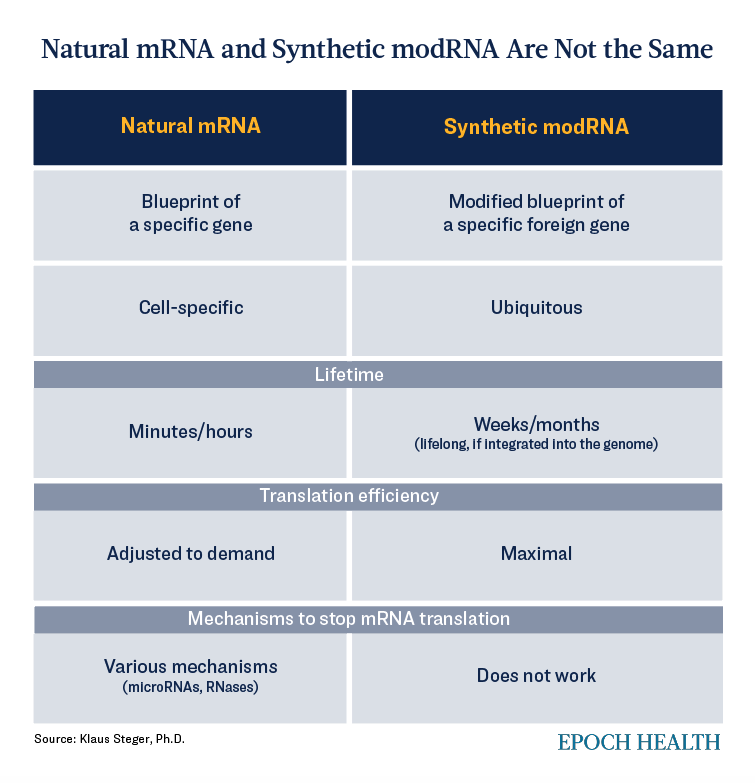COVID-19 Vaccines and Boosters Were Never Made With mRNA

Health Viewpoints
For the first time in human history, the gene regulatory program of healthy people has been manipulated on a massive scale.
Despite everything we’ve been told, RNA-based COVID-19 injections were manufactured with modified RNA—not messenger RNA (mRNA).
Modified RNA (modRNA) poses substantial risks to our health.
These risks come not only from COVID-19 injections and boosters but—unless we speak up now—also from all future RNA-based vaccines.
mRNA and modRNA Are Not the Same
The two—mRNA and modRNA—are completely different.
mRNA occurs naturally, lives in our cells for only a short time, and is relatively fragile. It is a specific type of RNA that carries instructions or “messages” from our genes to help make proteins, the building blocks of our cells. It is constantly produced as part of normal cellular processes. Once mRNA delivers the messages, its work is done, and it is broken down in the body.
When RNA from another source enters our cells—virus RNA, for example—these cells can generate virus proteins.
We have been told that COVID-19 injections are made with mRNA. However, a vaccine using “natural” mRNA would not last long enough to initiate an immune response before being destroyed by our immune system.
To make mRNA useful for routine medicine, scientists had to artificially modify mRNA to increase both its efficiency and lifetime. The result: modRNA.
modRNA has been optimized for long life and maximal translation. While mRNA exhibits a cell-specific expression pattern, modRNA can invade nearly every cell type.
How Did We Get Here?
In 1961, the announcement of the discovery of mRNA occurred “in a climax of scientific excitement.” There had been earlier “sightings” of this short-lived but essential RNA intermediary, all leading up to an understanding of how genes made mRNA and its role in the production of proteins.
In a nutshell: mRNA carries genetic instructions from the cell’s DNA to ribosomes, which use these instructions to assemble a specific protein.
It wasn’t long before scientists experimented with how to use mRNA to help the body heal itself. In 1990, researchers injected natural (unmodified) mRNA into a mouse’s skeletal muscle; the mouse produced a protein it would never produce naturally.
Subsequently, scientists observed that transferring natural mRNA was inefficient. Although it worked in principle, it broke down quickly and couldn’t be used effectively for treatment purposes.
This observation opened the door to synthetically or artificially modifying mRNA. The original focus of this research was to reprogram and destroy cancer cells—the only aim of modRNA before the COVID-19 pandemic.
modRNA 101
How is RNA modified? Simply put, one of the four compounds in RNA is modified (e.g., the natural nucleoside uridine is modified to make synthetic/artificial methyl-pseudouridine). The modRNA is then:
- More stable (it lasts longer in the body).
- Less immunogenic (it evokes reduced stimulation of the innate immune system).
- More efficient (modRNA produces more protein than the same amount of mRNA).
modRNA is created in a laboratory.
The therapeutic application of modRNA in humans presents challenges and dangers.
Alarmingly, modRNA contains a viral gene sequence. Upon entering a cell, modRNA takes control of the cell machinery and reprograms it to produce a viral protein—for example, spike protein.
Perhaps most astonishing is that, when creating the COVID-19 vaccines and boosters, scientists already knew that targeted delivery of modRNA was impossible. modRNA cannot be targeted to specific cells. As such, it attacks perfectly healthy cells—even beyond natural barriers like the blood-brain barrier.
The continuous production of an artificial viral protein robs the cell of energy, disrupts its metabolism, and leads to the cell no longer being able to perform its vital task for the organism as a whole.
What’s worse, with virus proteins generated in them, those cells are subsequently destroyed by our immune system.
Despite these dire shortcomings, Pfizer-BioNTech and Moderna launched a large-scale production of COVID-19 “vaccines” using modRNA.
The Body Responds Differently to Natural Infection Versus modRNA Injection
Spike protein is well known to represent a poison for our body.
In the case of natural infection, our immune system will prevent the virus from infecting our body cells by neutralizing it via specific antibodies, with the possibility of cross-immunity being effective also against virus variants.
With the modRNA injection, our immune system does not have a chance to prevent the lipid nanoparticles from transferring modRNA into our cells—all cells, not just some cells with the appropriate receptor for binding of the virus (as would be the case in natural infection).
The Virus and the Vaccine Are Not the Same
Though some have argued that the body’s response to the modRNA vaccine is similar to a response to the actual virus, this is not true.
First, let us look at the natural virus and our body’s response to it:
- The virus RNA is like a blueprint. It contains instructions for all the parts needed (not just for spike protein) to make a new virus.
- The virus RNA exists within a protein envelope. Our immune system would build various antibodies (not just against spike protein), thus building some degree of cross-immunity to deal with virus variants.
- The majority of respiratory viruses are prevented from entering our body by the immune system located in the oral and nasal mucosa. The virus does not inject its RNA into blood vessels but binds to a specific receptor on the cell surface and then directly injects RNA into the cell.
It must be emphasized that only specific cells (namely those carrying the appropriate receptor on the cell surface) can be infected.
Our immune system’s job is to destroy a cell that has been infected with a virus to prevent replication of the virus and subsequent infection of new cells. Notably, our immune system will stop the process once that battle is won (typically, within a few days).
Next, let us examine the body’s response to the modRNA injection (“the vaccine”):
- The vaccine contains modRNA for only the spike protein; therefore, vaccination provides no cross-immunity.
- The vaccine-modRNA has no protein envelope but is instead wrapped by a lipid nanoparticle.
- Lipid nanoparticles will not need receptors to enter a cell. Lipid nanoparticles are built of lipids, as is the cell membrane; therefore, both lipid membranes will simply merge.
- The immune system generates antibodies to combat antigens, which could include pathogens (viruses, bacteria), foreign particles (fungal spores, allergens), or any substances that provoke a specific immune response. However, the lipid nanoparticles that transport modRNA are devoid of these antigens, enabling them to bypass the specific immune system unnoticed and induce nonspecific inflammation. This dynamic triggers an escalation in the immune system’s activity, leading to the production of an increasing quantity of antibodies against the spike protein. Each subsequent booster dose of lipid nanoparticles delivers an escalating quantity of modRNA. This, in turn, prompts an uninterrupted production of new spike proteins.
- Vaccines are injected into muscle. However, it is nearly impossible to inject directly into a muscle cell (large syringe versus small cell). As muscles are strongly supplied with blood, very often, syringes will violate blood vessels. The normal situation will be that the vaccine will be placed between the muscle cells, the so-called intercellular space. Fluid in the intercellular space will be collected as lymph fluid, finally merging with the blood.
- The vaccine and booster modRNA will continue to produce spike protein (for weeks or even months, which is entirely different from a natural infection), as our cell machinery (e.g., the enzyme RNase) cannot destroy the artificial modRNA. Researchers have found that some severe cases of COVID-19 were not due to the presence of the virus but to a dysregulation of the immune system (called a “cytokine storm”).
Research Reveals modRNA’s Poor Safety Profile
Early preclinical studies generated optimism about the advantages of RNA-based injections. However, the ability to induce an immune response was less effective in humans than anticipated based on animal experiments.
A 2018 review published in Nature reported that “recent human trials have demonstrated moderate and in rare cases severe injection site or systemic reactions for different mRNA platforms.”
Hence, the focus shifted to modRNA.
Injected modRNA can result in thrombosis followed by stroke, myocardial infarction, or pulmonary embolism and can promote the formation of blood clots inside blood vessels.
Studying the open-access databases—including those in the United States, Europe, and the UK—on COVID-19 vaccine adverse effects, one can see that these risks have become real-life side effects for people who received the COVID-19 injections.
Just Released: Previously Confidential Report on COVID-19-Related Fatalities
In June 2023, in response to a Freedom of Information Act request, some of these adverse effects were made public when previously confidential reports by BioNTech to the European Medicines Agency (EMA) were released. The reports included data collected during a six-month period from December 2021 to June 2022 and cumulative data beginning December 2020 (pdf).
The data revealed 3,280 fatalities among a group of 508,351 individuals receiving the vaccine during a combined period that included clinical trials and postmarketing. These deaths, and tens of thousands of serious adverse events, happened during a period when the vaccine makers insisted the modRNA-based injections were safe.

It is nonsensical that any cell in our body would be programmed to produce as much of a viral protein as possible for as long as possible. This is highly contrary to natural viral infection and will result in hyperactivation of the immune system.
Forcing perfectly healthy people to take a gene-based modRNA injection—sold as a vaccine—is both unethical and dangerous.
Views expressed in this article are the opinions of the author and do not necessarily reflect the views of The Epoch Times. Epoch Health welcomes professional discussion and friendly debate. To submit an opinion piece, please follow these guidelines and submit through our form here.


No comments:
Post a Comment